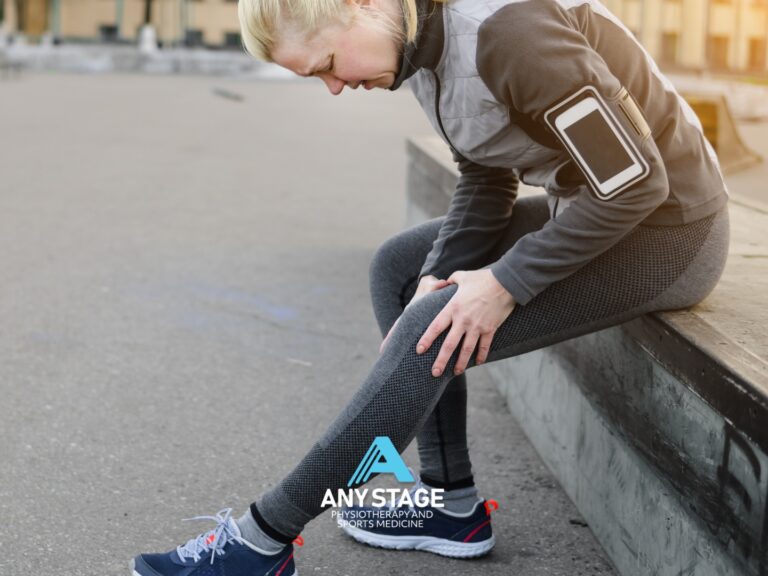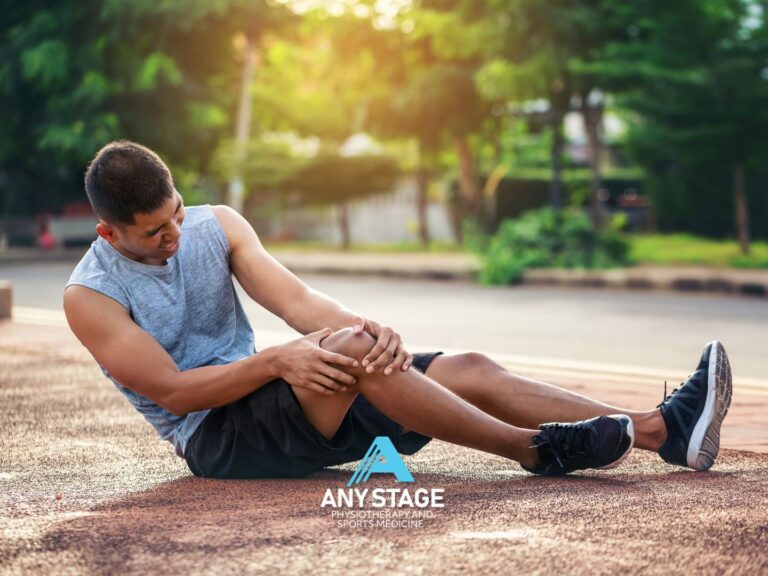What is syndesmosis ankle sprain?
A syndesmosis ankle sprain, also known as a high ankle sprain, is an injury that affects the syndesmotic ligaments that connect the tibia and fibula bones in the lower leg. Unlike a typical lateral ankle sprain that involves the stretching or tearing of the ligaments on the outer side of the ankle, a syndesmosis sprain occurs when there is damage to the ligaments that hold the tibia and fibula together above the ankle joint.
Anatomy
The syndesmotic ligaments provide stability to the ankle joint and help maintain the proper alignment of the tibia and fibula bones. These ligaments include the anterior inferior tibiofibular ligament (AITFL), the posterior inferior tibiofibular ligament (PITFL), and the interosseous ligament. When a syndesmosis sprain occurs, it can lead to instability, pain, and difficulty with weight-bearing activities.
Mechanism
Syndesmosis sprains typically occur due to a forceful external rotation or excessive dorsiflexion of the foot, such as in sports activities involving sudden twisting or pivoting movements. The injury is more common in athletes, particularly in sports like football, soccer, basketball, and skiing.
Common symptoms of a syndesmosis sprain include
- Pain above the ankle joint, often on the lower leg or on the front of the ankle.
- Swelling and bruising around the ankle.
- Difficulty bearing weight or walking, especially on uneven surfaces.
- Instability or a feeling of the ankle giving way.
- Pain during external rotation or dorsiflexion of the foot.
During a syndesmosis injury, the ligaments and the surrounding structures may undergo various degrees of damage. Syndesmosis injuries are often graded based on the severity of the damage to the syndesmotic ligaments. The grading system helps physiotherapists and healthcare professionals determine the appropriate treatment approach and estimate the expected recovery time.
Commonly used grades for syndesmosis injuries
- Grade I: Grade I syndesmosis injuries involve a mild stretching or partial tearing of the syndesmotic ligaments. The ligaments remain intact, but there may be some minor damage or disruption. Symptoms typically include mild pain, minimal swelling, and minimal loss of function. An athlete with a grade I injury may still be able to bear weight and walk relatively normally. A return to physical activity may take up to 6-weeks, with a return to sport taking slightly longer depending on the demands of the sport.
- Grade II: Grade II syndesmosis injuries involve a partial tear of one or more of the syndesmotic ligaments. There is a more significant disruption compared to a grade I injury. This can result in moderate pain, swelling, and functional limitations. Weight-bearing activities may be more challenging, and the ankle may feel unstable or give way during certain movements. Often a boot is used for the first week or so to off-load the ankle, allowing for healing to occur. Typical recovery of a grade II injury is between 6-12 weeks. However, an orthopaedic review is also considered to determine whether the joint is unstable. If the joint is considered unstable, surgery may be required.
- Grade III: Grade III syndesmosis injuries are characterised by a complete tear or rupture of one or more of the syndesmotic ligaments. The ligaments are significantly disrupted, leading to marked instability of the ankle joint. Symptoms include severe pain, significant swelling, and considerable functional impairment. Weight-bearing may be extremely difficult or impossible, and the ankle may feel highly unstable or completely unstable. A referral for an orthopaedic review and surgery is considered the best course of action. Recovery and return to physical activity is between 3-6 months.
In addition to the ligaments and bones, other structures such as the surrounding muscles, tendons, and blood vessels can be affected in a syndesmosis injury, leading to pain, swelling, and impaired function. Accurate diagnosis of a syndesmosis injury is crucial for appropriate treatment planning. Imaging techniques, such as weight bearing X-rays, stress X-rays, or MRI scans, may be used to evaluate the integrity of the syndesmotic ligaments and assess the extent of the injury.
Treatment options for a syndesmosis sprain
- Rest and Immobilisation: Initially, the ankle may be immobilised using a brace, cast, or walking boot to allow the ligaments to heal. Crutches may be used to assist with weight-bearing and to prevent further injury.
- Ice and Elevation: Applying ice and elevating the ankle can help reduce swelling and pain.
- Physiotherapy: Once the acute phase subsides, physiotherapy is important to restore strength, range of motion, and stability to the ankle. Therapeutic exercises, such as range of motion exercises, strengthening exercises, balance and proprioceptive training, and functional activities, are commonly prescribed. Our team at Any Stage Physiotherapy are able to accurately diagnose the level of injury, refer to the appropriate specialists and prescribe an individualised treatment plan based on your level of injury and help you return to your sport/daily routine.
- Gradual Return to Activity: The individual’s return to activity or sport is based on the severity of the injury and the progress made in rehabilitation. A gradual return to weight-bearing, sports-specific training, and higher-level activities is typically recommended.
Orthopaedic review on syndesmosis sprains
In some cases, severe syndesmosis sprains with significant ligament damage may require surgical intervention. Our physiotherapists at Any Stage Physiotherapy and Sports Medicine work closely with a wonderful team of surgeons. If the injury requires, we can make a referral to the necessary surgical team and fast track your recovery.
Returning to sport following a syndesmosis injury
A return to sport requires a systematic and gradual approach to ensure proper healing, restoration of strength and stability, reducing risk of re-injury. The specific steps may vary depending on the severity of the injury, individual factors, and guidance from our physiotherapists.
Below is a general outline of the steps involved in returning to sport after a syndesmosis injury
- Rehabilitation Phase I: Once you are guided through the steps of reducing pain and swelling, a supervised rehabilitation program will be introduced. This phase focuses on restoring range of motion, improving muscle activation, and gradually reintroducing weight-bearing activities. Our physiotherapy approach may include manual therapy techniques, gentle stretching exercises, joint mobilisation techniques, and gradual strengthening exercises targeting the ankle, calf, and lower leg muscles.
- Rehabilitation Phase II: Progression to more advanced exercises aimed at strengthening the ankle, improving proprioception, and enhancing balance and stability. This phase may include resistance training, proprioceptive exercises on unstable surfaces, and sport-specific drills. The focus is on gradually increasing the load and intensity of exercises while ensuring proper form and technique.
- Sport-Specific Training: Once adequate strength, stability, and functional performance are achieved, our approach is to incorporate sport-specific training activities into the rehabilitation program. This may involve specific drills, agility exercises, and movements that mimic the demands of your particular sport or activity. Gradually progressing the intensity, complexity, and duration of these exercises to simulate game-like conditions is the goal of this phase.
- Return to Full Sports Participation: Before returning to full sports participation, it is essential to ensure that the ankle is fully healed, functional, and able to withstand the demands of the sport. This may involve a comprehensive evaluation by a sports doctor (depending on the degree of the initial injury), including a functional assessment, sport-specific movement analysis, and assessment of the ankle’s stability. Specific testing and assessments will be carried out by our physiotherapists at Any Stage Physiotherapy and Sports Medicine, to ensure your confidence has been restored and your ankle has the ability to perform all physical demands. Clearance from the physiotherapist and/or medical team is crucial to ensure readiness for full sports participation.
- Maintenance and Injury Prevention: Even after returning to sport, it is important to continue with ongoing strength and conditioning exercises, as well as injury prevention strategies. This includes regular ankle strengthening exercises, plyometric training, balance training, and maintaining overall physical fitness. Proper warm-up, cool-down, and stretching routines, as well as the use of appropriate taping techniques and/or ankle brace, can help reduce the risk of re-injury.
Timeline
Each phase of rehabilitation and return to sport may vary depending on the severity of the injury, individual progress, and guidance from healthcare professionals. Our patient centred approach allows our team of physiotherapists to work closely with you, assisting you with each step of the rehabilitation process, ensuring a safe and successful return to sport following a syndesmosis injury.


Final thoughts on syndesmosis ankle sprain
If you have experienced a recent ankle injury, or, you have persistent ankle pain, please do hesitate to contact our friendly and experienced team at Any Stage Physiotherapy and Sports Medicine. We are here to guide you back to a pain free lifestyle and help return you to sport.
Authors


Daniel Lee
DPT, B. Sc, APAM
Director / Principal Physiotherapist
Daniel Lee has created a specialised approach to Physiotherapy treatment, return to sport and injury prevention by incorporating a functional strength & conditioning approach, no matter the individual’s age, sport, lifestyle, or competition level.

Shannon Murray
DPT, B. HSc, APAM
Physiotherapist
Shannon completed her Doctor of Physiotherapy degree at Macquarie University, after relocating from Queensland, where she completed her Bachelor of Health Science degree. Whilst completing her Doctor of Physiotherapy degree, she gained valuable experience in various setting, including private practice and hospital.









